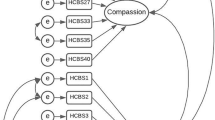Abstract
Two hundred and forty child molester paraphiliacs, 48 non-child molesting paraphiliacs and 86 non-paraphiliacs were administered a 29 item Likert scale of statements designed to determine: 1) if cognitive distortions concerning child molestation exist among child molesters and (2) if child molesters can be discriminated from non-child molesters by assessing their cognitive distortions. Factor analysis yielded six factors covering the general area of child molestation being harmful to the child. The factors were reliable and successfully separated child molesters from non-child molesters. Results confirmed that child molesters not only vary from non-child molesters by their behavior with children, but also by their cognitions or beliefs about the consequence of their child molestation behavior on the child.
Similar content being viewed by others
References
Abel, G.G., Becker, J.V., & Cunningham-Rathner, J. (1984). Complications, consent and cognitions in sex between children and adults.International Journal of Law and Psychiatry, 7, 89–103.
Abel, G.G., Becker, J.V., Cunningham-Rathner, J., Rouleau, J.L., Kaplan, M., & Reich, J. (1984).Treatment manual: The treatment of child molesters. Atlanta: Emory University.
Abel, G.G., & Blanchard, E.B. (1974). The role of fantasy in the treatment of sexual deviation.Archives of General Psychiatry, 30, 467–475.
Abel, G.G., Blanchard, E.B., & Becker, J.V. (1977). An integrated treatment program for rapists. In R.T. Rada (Ed.),Clinical aspects of the rapist, (pp. 161–214) New York: Grune & Stratton.
Abel, G.G., Mittleman, M.S., & Becker, J.V. (1985). Sexual offenders: Results of assessment and recommendations for treatment. In M.G. Ben-Aron, S.J. Hucker, and C.D. Webster, (Eds.),Clinical criminology: the assessment and treatment of criminal behavior, (pp. 191–205). Toronto. University of Toronto and M & M Graphics, Ltd.
Abel, G.G., & Rouleau, J. L. (1989). Outpatient treatment of sex offenders. In M.E. Thase, M.A. Edlestein, & M. Hersen (Eds.),Handbook of outpatient treatment of adults. New York: Plenum Press (in press).
Abel, G.G., Rouleau, J.L., & Cunningham-Rathner, J. (1986). Sexually aggressive behavior. In W.J. Curran, A. McGarry, & S. Shah, (Eds.),Forensic psychiatry and psychology: Perspectives and standards for interdisciplinary practice, (pp. 289–313). Philadelphia: F.A. Davis.
Araji, S., & Finkelhor, D. (1983).Explanations of pedophilia: Review of empirical research. Durham, NH: University of New Hampshire.
Bagley, C. (1986). Mental health and the in-family sexual abuse of children and adolescents. In B. Schlesinger (Ed.)Sexual abuse of children in the 1980's. Toronto: University of Toronto Press.
Bandura, A. (1969).Principles of behavior modifications. New York: Holt, Rhinehart & Winston.
Bandura, A. (1973).Aggression: A social learning analysis. Englewood Cliffs, New Jersey: Prentice-Hall.
Bandura, A. (1977).Social learning theory. Englewood Cliffs, New Jersey: Cognitive Prentice-Hall.
Becker, J.B., & Abel, G.G. (1985). Methodological and ethical issues in evaluating and treating adolescent sexual offenders. InAdolescent sex offenders: Issues in research and treatment. Department of Health and Human Services Publication No. ADM 85-1396 Washington, D.C.: U.S. Government Printing Office.
Ellis, A. (1970).The essence of rational psychotherapy: A comprehensive approach to treatment. New York: Institute for Rational Living.
Finkelhor, D. (1984).Child sexual abuse. New York: The Free Press.
Gibbs, J.C. (1989). Social processes in delinquency: The need to facilitate empathy as well as sociomoral reasoning. In W.M. Kurtines & J. Gerwitz (Eds.),Moral development through social interaction. New York: Wiley & Sons.
Groth, A.N. (1983). In J. Greer, & I. Stuart (Eds.),The sexual aggressor: Current perspectives and treatment. New York: Van Nostrand.
Knopp, F.H. (1982).Remedial intervention in adolescent sex offenses: Nine program descriptions. New York: Safer Society Press.
Nedoma, K., Mellan, J., & Pondelickova, J. (1981). Sexual behavior and its development in pedophilic men.Archives of Sexual Behavior, 7, 267–271.
Quinsey, V. (1977). The assessment and treatment of child molesters: A review.Canadian Psychology Review, 18, 204–218.
Russell, A.B., & Mohr-Trainor, C. (1984).Trends in child abuse and neglect: A national perspective. Denver: American Humane Association.
Schwartz, M., & Masters, W.H. (1983). Conceptual factors in the treatment of paraphilias: A preliminary report.Journal of Sex and Marital Therapy, 9, 3–18.
Sykes, G., & Matza, D. (1957). Techniques of neutralization.American Sociological Review, 22, 664–670.
Trapper, T. & Barrett, M.J. (Eds.). (1986).Treating incest: A multiple systems perspective. New York: Haworth Press.
Travin, S., Bluestone, H., Coleman, E., Cullen, K., & Mellala, J. (1986). Pedophile types and treatment perspectives.Journal of Forensic Sciences, 31, 614–620.
Wilson, G.T. (1978). Cognitive behavior therapy: Paradigm shift or passing phase? In J. Foryet, & D. Rathjen, (Eds.),Cognitive behavior therapy. New York: Plenum Press.
Yochelson, S. & Samenow, S.E. (1977).The criminal personality, Vol I & II. New York: Jason Aronson.
Zigler, E.F., Lamb, M., & Child, I. (1982).Socialization and personality development. New York: Oxford University Press.
Author information
Authors and Affiliations
Rights and permissions
About this article
Cite this article
Abel, G.G., Gore, D.K., Holland, C.L. et al. The measurment of the cognitive distortions of child molesters. Annals of Sex Research 2, 135–152 (1989). https://doi.org/10.1007/BF00851319
Issue Date:
DOI: https://doi.org/10.1007/BF00851319




